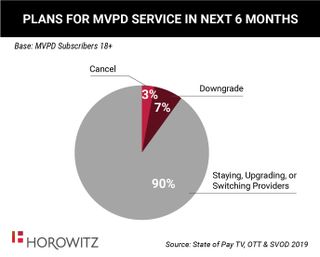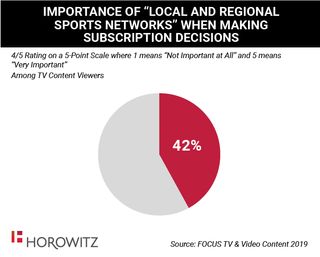How Regional Sports Nets Fit Into Cable’s Lineup
Regional sports networks have been popping up with increasing frequency, with Dish Network having just blacked out Altitude, the Denver market’s regional sports network, and still in a holding pattern with the Fox Sports channels and YES Network; MSG reporting a 6.5% drop in subscribers; and Sinclair Broadcast Group closing its deal to acquire all 21 Fox Sports RSNs and Fox College Sports.

MoffettNathanson’s latest predictions have linear pay TV services declining 5.5%. According to Horowitz’s State of Pay TV, OTT & SVOD 2019, the biggest reasons cord-cutters cite for no longer having a traditional MVPD are — unsurprisingly — costs and unexpected bill increases. In this context, is the value of RSNs for customers enough to justify their high cost? And what makes RSNs a potential blackout target, while ESPN seems safe?
The math is a little different for every provider, and the equation needs to take into account not only the hard costs but also the soft costs of the impact on brand perception. When discussing the decision to drop Fox Sports and YES, Dish chairman Charlie Ergen conceded the satellite provider was likely to lose some customers if RSNs never returned, but maintained that it was likely the right decision in the long run. With Dish’s reputation of being a low-cost provider, it may be a tradeoff customers are willing to make. The same, though, cannot be assumed for other providers.

While cord-cutting has accelerated, the reality is still that the majority of Americans subscribe to a traditional linear pay TV service — and most have no intention of going anywhere. Ninety percent of traditional MVPD subscribers are not planning to leave the linear pay TV ecosystem in the next six months (they are either staying with their provider, upgrading their service by adding channels, tiers, or services/boxes or switching providers). The continued stickiness of traditional pay TV shows that the price-value equation remains in some kind of balance for the majority of the U.S. population.
There are a number of reasons that the traditional pay TV model still appeals to the majority of viewers, not the least of which is their desire for live content — and for many consumers, one of the most important genres of live content is sports. A big part of the value of live content is that viewers don’t want to know the ending, whether that is a scripted drama, reality TV, news or sports.
In the qualitative research we conduct, we often hear that a key reason why people continue to watch live TV is that they don’t want to see spoilers on social media; if they aren’t able to watch something live, they will intentionally stay off social media to maintain the element of surprise.
With sports, where the drama can come down to the second, even a 10- or 15-second delay can mean that someone has already posted on social media, texted or otherwise ruined the game-winning play. In our qualitative research, we have encountered cord cutters who have access to live streams of sports events, but have actually added an antenna to their home so they can watch games live over-the-air without worrying about lag, buffering, or the stream cutting out.
During some recent high-profile disputes, there have been (relatively) easy alternatives to appease customers. When Dish blacked out HBO, overlapping with Game of Thrones’s final season, customers who wanted to access HBO had a number of options: subscribing to HBO Now, borrowing a friend or family member’s login information to access HBO Go or Now, subscribing to any of the vMVPDs or adding HBO Now on to their Amazon or Hulu subscriptions.
Dish even went so far as to provide directions to its customers on how to subscribe to HBO Now, which cost consumers the same as it would have if they had subscribed through Dish — so it was really a minimal disruption. For AT&T and CBS (now resolved), the solution was also relatively easy: direct consumers to CBS All Access or over-the-air options.
Sports fans who watch RSNs, on the other hand, have limited alternatives. There are no direct-to-consumer alternatives: no network apps and no ability to add an RSN directly to Amazon Channels or Hulu, like HBO or other premium networks. Virtual MVPDs may be an option in some cases, although it would be substantially more expensive than adding just one channel and for some, the potential issues with streaming mentioned earlier (lag, buffering or the stream dropping out) might be more than they are willing to compromise on. Antennas are another option, but while over-the-air channels do provide coverage of regional sports, it is only a fraction of the total number of local games. For avid sports fans, having “some” games is not enough; the only real option is to have a traditional MVPD service that offers regional sports networks.

In fact, according to data from Horowitz’s FOCUS TV & Video Content 2019, released in August, 42% of TV content viewers consider regional and local sports networks important when they make decisions about what services to subscribe to; more than half of those (24%) ascribe a full “five” rating on a five-point importance scale. With more than four in 10 viewers reporting that regional sports is an important part of their subscription decision, it is unquestionable that RSNs hold serious value. There is every reason to believe that, given the lack of alternatives, dropping regional sports will cause some fans not to cut the cord but to switch providers.
With the baseball season coming into its home stretch and the NBA and NHL seasons coming up, the value of RSNs will really be put to the test.
Stephanie Wong is director, insights & strategy at New Rochelle, New York-based research firm Horowitz Associates.
Multichannel Newsletter
The smarter way to stay on top of the multichannel video marketplace. Sign up below.



